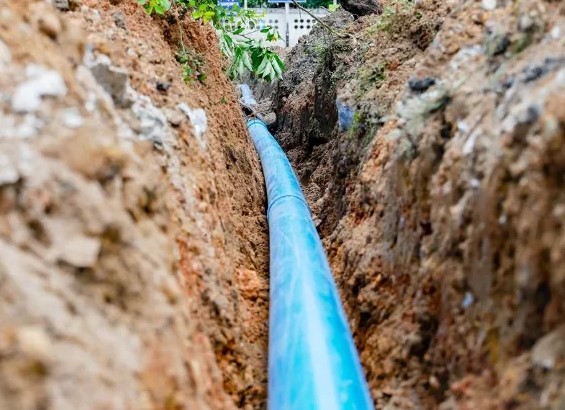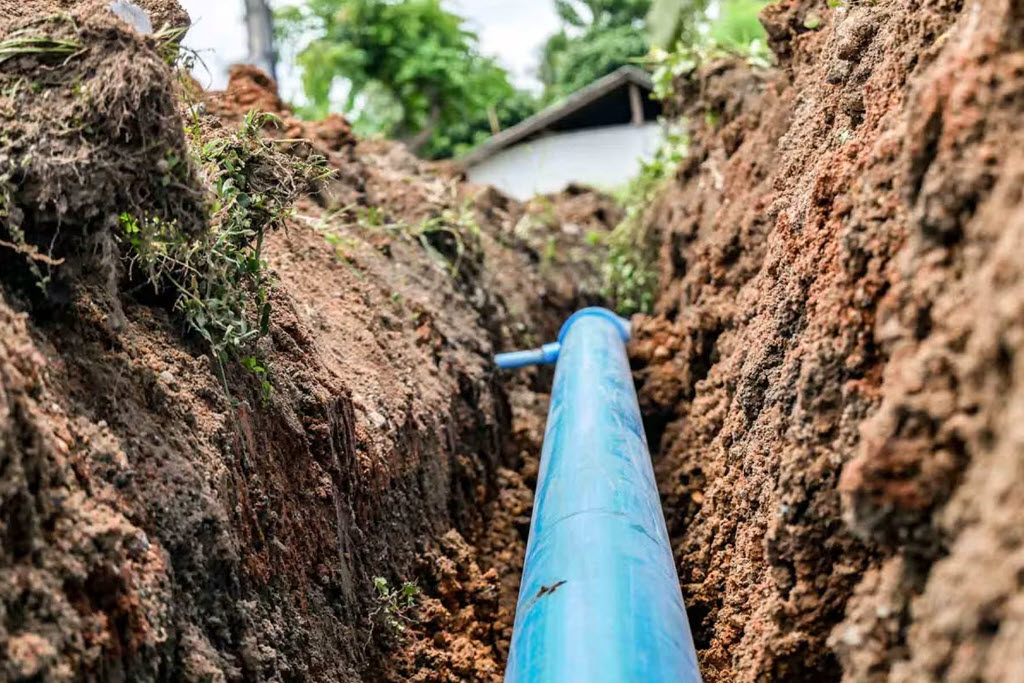Water Line Servicesin Clay Township MI
Water Line Installation to Ensure Steady and Clean Water Supply
We Are Locally Owned & Operated For Over 37 Years
Contact Us Today!
We Serve Businesses In And Around The Following Cities:
About Water Line Services
Introduction
Water lines are at the heart of a city’s infrastructure, particularly in commercial settings. They cater to every business’s fundamental need for a safe and reliable supply of water. In Clay Township, the role of water lines for commercial properties is as crucial as it is anywhere else – enabling everything from the day-to-day operation of businesses and industrial processes to fire protection. Understanding the process of their installation, maintenance, and repair—along with the multitude of benefits they offer—can be incredibly beneficial for commercial property owners and managers. This guide aims to shed light on this vital infrastructure component, incorporating references to an array of water line types, from the standard pex water line to the more sophisticated trenchless water line replacement.
Understanding Water Lines
Whether it’s a main water line leading to a house or a commercial property, water lines provide an essential connection to the community’s water source. The bulk of these lines are hidden underground and are designed out of durable materials such as copper or polyethylene that can withstand environmental strains. The underground water line is also often insulated to protect from elements that might adversely affect its function. However, there might still be cases when one would need water line repair services near their locality, such as from D&J Contracting.
Types of Water Lines
A range of materials can be used for water lines, each offering unique benefits. Among the most common are copper water lines, renowned for their durability and resistance to corrosion. However, for those seeking flexibility to maneuver around obstructions, flex water lines, or flexible water lines, are an excellent choice.
Increasingly popular, however, is the PEX water line – a flexible, plastic piping material which is easy to install and resistant to scale and chlorine. There’s also the robust nature of the black water line, typically employed in wastewater management applications. However, whatever the choice, whether for toilet water lines, sink water lines, or main lines, regular maintenance and timely water line replacement are essential to ensure their long-term performance.
Benefits of Efficient Water Line Management
A well-maintained water service line is a valuable asset for any business. It ensures a steady, uninterrupted water supply – critical not only for normal business operations but also for safeguarding the health of employees and customers. It’s also important to safeguard against any potential main water line leak, given the steep repair cost. So, good water line management makes financial sense, too.
Trenching and Trenchless Water Line Replacement
There may come a time when a water line, no matter how well-maintained, may need replacement. Traditional replacement methods involve trenching, a disruptive process that could disturb landscapes and traffic. Fortunately, there’s a modern alternative – trenchless water line replacement. This advanced technology, offered by service providers like D&J Contracting, allows a water line to be replaced or repaired with minimal surface disruption, making it a popular choice for commercial properties in Clay Township.
Choosing the Right Service Provider
Opting for competent professionals for your water line services is vital. Look for service providers with a range of expertise, including main water line repair, water line caps, and water line replacement. Companies like D&J Contracting also provide 24/7 emergency services, ensuring swift repairs to avoid downtime in commercial operations. Coupled with their localized knowledge of Clay Township and practical insights yielded from experience, the benefits are immeasurable.
Final Reflection
As demonstrated, understanding the ins and outs of water lines – their types, installation, and maintenance – is fundamental for efficient commercial property management. It’s not just about securing an efficient water supply; it saves time and costs down the line and staves off potential issues proactively. Businesses would do well to make educated decisions about their water line services and opt for dependable providers like D&J Contracting with their diverse offering of services and localized knowledge. After all, it means more than merely keeping the taps running – it signifies pillar-like support for your commercial operations and, by extension, your business growth.
Water Line Services Gallery


Call Us Today to receive your Free Quote for
Water Line in Clay Township
Serving: Clay Township, Michigan

About Clay Township, Michigan
The area was first settled by John Martin in 1805, and the area was originally referred to as Pointe du Chene (Oak Point). In 1826, the area was organized as Plainfield Township, which was named by early settler John K. Smith after his hometown of Plainfield, Vermont. A post office named Plainfield began operating here on April 5, 1826 with Smith serving as the first postmaster. In 1828, the township was reorganized and renamed after attorney and statesman Henry Clay, and the post office was later renamed Clay on December 23, 1835; Smith continued serving as postmaster. The post office was renamed Algonac on August 17, 1843. Algonac incorporated as a village within Clay Township in 1867. The village gained autonomy from the township when it incorporated as a city in 1967.
- Colony Tower Complex
- Harsen House
- LeRoy Smith House
- North Channel Shooting Club
- St. Clair River Informational Designation
- Stewart Farm / Memoir of Aura Stewart
- St. Clair Flats Front and Rear Range Light
According to the U.S. Census Bureau, the township has a total area of 82.47 square miles (213.60 km), of which 35.32 square miles (91.48 km) is land and 47.15 square miles (122.12 km) (57.17%) is water.
The township contains a large portion of water that includes areas along the St. Clair River mouth in the northern Anchor Bay area of Lake St. Clair, which contains numerous channels and canals. Directly across the river is the Walpole Island First Nation in Ontario, which is accessible via the Walpole–Algonac Ferry in downtown Algonac.
The St. Clair Flats State Wildlife Area and the majority of the St. John’s Marsh State Wildlife Area are located within Clay Township. Most of Algonac State Park is located within Clay Township with a small portion extending north into Cottrellville Township.
- Bedore is an unincorporated community located along the southern coast of Harsens Island at 42°33′28″N 82°36′47″W / 42.5578126°N 82.6129630°W.
- Clays Landing is an unincorporated community located at the southern terminus of M-154 on Harsens Island at 42°33′06″N 82°36′16″W / 42.5517016°N 82.6043512°W.
- Forster is an unincorporated community located just west of Bedore at 42°33′40″N 82°37′06″W / 42.5611459°N 82.6182410°W.
- Grand Pointe is an unincorporated community located in the northeastern area of Harsens Island at 42°35′58″N 82°32′43″W / 42.5994788°N 82.5451844°W. The affluent community was settled as early as 1888 by the Grand Pointe Improvement Company, and a post office operated briefly from October 16, 1889 until January 5, 1892.
- Harsens Island is the name of the post office that serves the island and several surrounding islands. Harsens Island was first settled as early as 1779 by James Harsen, who was the area’s first white settler. By 1783, Harsen had purchased the entire island from its native Indian population. As late as 1809, the island was also known as James (also Jacob or Jacobus) Island. The post office began operating under the name Sans Souci on April 24, 1900 and was renamed Harsens Island on December 31, 1960. The post office uses the 48028 ZIP Code.
- Maple Leaf is an unincorporated community located on Harsens Island just southwest of the community of Sans Souci at 42°34′41″N 82°34′11″W / 42.5780902°N 82.5696288°W.
- Miller is an unincorporated community located near the southernmost end of Harsens Island at the end of public road access at 42°32′57″N 82°39′32″W / 42.5492017°N 82.6587976°W.
- Muirs is an unincorporated community located along M-154 on Harsens Island at 42°33′23″N 82°35′14″W / 42.5564238°N 82.5871285°W.
- Pearl Beach is an unincorporated community and census-designated place (CDP) located along the southern end of the mainland at 42°37′36″N 82°35′52″W / 42.6267006°N 82.5976876°W.
- Perch Point is an unincorporated community located along M-29 in the northwestern portion of the township along the border with Ira Township at 42°39′54″N 82°37′13″W / 42.6650333°N 82.6201900°W.
- Pointe aux Tremble is an unincorporated community located along M-29 within the Pearl Beach CDP at 42°37′17″N 82°34′16″W / 42.6214230°N 82.5710196°W. The community was settled in 1904 as a station along the railway about 3.0 miles (4.8 km) west of Algonac.
- Riverside is an unincorporated community located in the southern portion of Harsens Island at 42°33′32″N 82°37′49″W / 42.5589237°N 82.6301859°W.
- Roberts Landing is an unincorporated community located along M-29 near Algonac State Park along the border with Cottrellville Township at 42°39′35″N 82°30′57″W / 42.6597561°N 82.5157415°W. The community was named after its first settler, who arrived here in 1830. The Roberts family settled the area as a popular fishing and hunting destination. A post office operated here from April 29, 1869 until December 15, 1895.
- Sans Souci is an unincorporated community located on Harsens Island at 42°34′52″N 82°33′44″W / 42.5811490°N 82.5621580°W.
As of the census of 2000, there were 9,822 people, 3,934 households, and 2,844 families residing in the township. The population density was 277.0 inhabitants per square mile (107.0/km). There were 5,325 housing units at an average density of 150.2 per square mile (58.0/km). The racial makeup of the township was 97.92% White, 0.20% African American, 0.68% Native American, 0.11% Asian, 0.21% from other races, and 0.87% from two or more races. Hispanic or Latino of any race were 0.85% of the population.
There were 3,934 households, out of which 27.9% had children under the age of 18 living with them, 61.3% were married couples living together, 7.0% had a female householder with no husband present, and 27.7% were non-families. 22.9% of all households were made up of individuals, and 9.2% had someone living alone who was 65 years of age or older. The average household size was 2.50 and the average family size was 2.94.
In the township the population was spread out, with 22.6% under the age of 18, 6.5% from 18 to 24, 28.2% from 25 to 44, 28.8% from 45 to 64, and 13.9% who were 65 years of age or older. The median age was 41 years. For every 100 females, there were 103.6 males. For every 100 females age 18 and over, there were 103.2 males.
The median income for a household in the township was $55,059, and the median income for a family was $63,182. Males had a median income of $48,053 versus $31,923 for females. The per capita income for the township was $27,169. About 2.3% of families and 4.7% of the population were below the poverty line, including 6.7% of those under age 18 and 3.6% of those age 65 or over.
Call Us Today to receive your Free Quote for
Water Line in Clay Township
Related Services in Clay Township, Michigan
We Serve Businesses In The Following Zip Codes:
48007, 48015, 48021, 48026, 48035, 48036, 48038, 48042, 48043, 48044, 48045, 48046, 48047, 48048, 48050, 48051, 48066, 48071, 48080, 48081, 48082, 48083, 48084, 48085, 48088, 48089, 48090, 48091, 48092, 48093, 48098, 48099, 48225, 48230, 48236, 48310, 48311, 48312, 48313, 48314, 48315, 48316, 48317, 48318, 48397